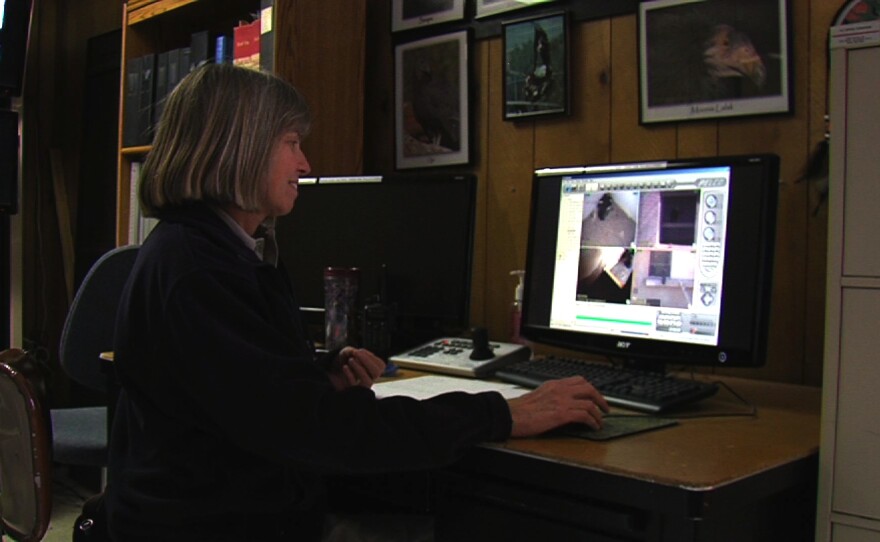It is hatching time for endangered California condors. The first chick born this year at the San Diego Zoo Safari Park emerged from its shell two weeks ago.
More than 170 chicks have hatched there since a breeding program was established in the 1980s, but the enthusiasm over the chicks is tempered by challenges facing a species still trying to fight back from the brink of extinction.
A handful of keepers are spending a lot of time in a tiny little trailer in a remote section of the Safari Park. Nearly every corner of the nearby condor breeding area can be monitored from here. Longtime condor keeper Don Sterner said all the paired birds are watched closely.
"We have cameras in their nest boxes, to make sure pairs are compatible. That they work well together. We sometimes will put artificial eggs in with a pair, just find out that they are working well together, before we actually risk real eggs," said Sterner.
Biologists consider each egg a precious commodity. Thirty years of recovery and captive breeding have led to some remarkable achievements, but the species is not yet self-sustaining.
"Even though there are a little over 400 birds now, 400 California Condors in the world, that's still not very many condors," said Sterner.
But that is a lot more than there were in the 1980s. The population of condors fell to 22 birds before biologists launched a controversial effort to capture all remaining wild condors.
Breeding efforts in San Diego, Los Angeles, Oregon and Idaho have refined the science that's allowed biologists to swell the specie's numbers.
Keepers exploited the birds' parenting instincts to encourage them to lay two eggs each spring, instead of one. And Sterner says keepers use realistic puppets to help raise the chick from the first egg.

"It looks like a condor head," said Sterner. "And that's what they get used to as providing for their food and so forth. There obviously are shortcomings. Puppets don't have body language like a real condor does. But it's as close as we can get."
The first chick born this year is already thriving under the watchful eyes of keepers. The fist-sized bird eats up to 15 mice a day.
Keepers use the puppet to feed and stimulate the bird, all the while remaining out of sight behind a black screen. That's important because every bird born in captivity could end up in the wild.
"To see the start of a little egg I've been able to watch develop over a period of eight weeks," said Sterner. "And then it is this little chick and it grows up into this big bird that weighs over 20 pounds with a nine foot wingspan. And then you see it flying out in the wild is just absolutely an awesome experience. It's amazing."

Michael Mace spent years overseeing the recovery effort in San Diego. He is the curator of birds at the San Diego Safari Park.
Half the condors alive today are flying free in their historical ranges, according to Mace. There are condor release programs in central California, Arizona and Mexico.
"We knew that if we made some adjustments in the environment that we would have the ability to save this species," said Mace. "And I think the fact that we've gone from 22 birds now to more than 400, with more than half of those in the wild, those producing their own offspring, we have made great strides."
But the bird's flight to recovery has not always been as easy as riding a thermal in the back country. Condors faced a deadly threat from mosquitoes carrying the West Nile Virus.
Zoo biologists worked with the Centers for Disease Control to develop a vaccine, and then all condors in the wild were inoculated.

And the ancient birds have to deal with ongoing threats created by people. The most prominent is lead poisoning.
"Condors are scavengers and so they come down sometimes and feed on carcasses that have been taken as game. And when they do that they accidentally ingest lead during their feeding activities," said Mace.
Efforts to outlaw lead bullets have largely failed, although they are ongoing. There are other threats, too. Trash created by humans has to be dealt with if the condors are to survive.
"The playing field, in a program like this, is constantly changing," said Mace. "What we have to do is either react to the new circumstances or try to anticipate what some of those challenges might be."
Biologists have done fairly well in managing the complicated $2 million-a-year recovery effort. Diligence remains a requirement.
"The chicks that we raise today, if they make it through their life span, will be with us more than 60 years. So it's critical that we reduce or eliminate these obstacles that are in the way of recovering a species like condors," said Mace.
And the recovery effort is important, not just for condors. The birds are considered an umbrella species, according to Mace, and their range in the wild is immense. Making that range safe for condors makes it safe for lots of other species, too.






